Non-linear methods of time series analysis provide information on the physiological processes generating the EEG and can be used to recognize the interhemispheric EEG relationships in different vigilance states. In anaesthesia, there is low frequency EEG synchronization with an organized and distinguishable pattern which depends on the anaesthetic agent and the level of anaesthesia. The present work aims at analysing non-linear interdependencies between two symmetric EEG channels during the anaesthesia induction with propofol. The results will be contrasted with those obtained after univariate spectral analysis calculating the EEG power spectral densities within different frequency bands.
Fourteen patients aged 40 ± 15 years undergoing reconstructive surgery participated in this study, performed according to the guidelines of the local ethics committee for human studies. The anaesthesia was induced and maintained with propofol, given via a Target Controlled Infusion algorithm in a concentration range of 0.00-6.0 µg ml-1. EEG was recorded with Ag-AgCl electrodes from C3-C4 according to the international 10-20 system. The interdependence between two reconstructed state spaces was made according to Arnhold et al. (1999) and Pereda et al. (2002). The real existence of interdependence was demonstrated by comparing the original value of the Arnhold’s similarity index (S) with that obtained from 19 univariate surrogate versions of the time series. If the S value for the original X-Y pair results is greater than the value obtained for the 19 pairs of the original X-surrogate Y, then the difference is considered to be significant for P < 0.05 (Student’s paired t test).
The S indexes showed a significant decrease (P < 0.01, ANOVA) in the interdependence between both electrodes when the dose surpassed 2.20 µg ml-1. At this point, a marked inflexion occurred, showing that the dynamic behaviour of the EEG changed. Instead, applying the univariate spectral techniques the differences only appeared in the delta band at doses higher than 2.20 µg ml-1 (P < 0.01, ANOVA).
Our results agree with Zhang et al. (2001), who suggested that non-linear indexes show greater sensitivity than linear ones, especially when related to anaesthetic studies. A change in the dynamics of the EEG has been shown over a certain dose, which confirms the usefulness of the multivariate non-linear indexes to assess the depth of surgical anaesthesia.
This work was partially supported by the FIS 020194, MCyT BFI2002-01159 and NGN-4372 of the NWO-STW.

